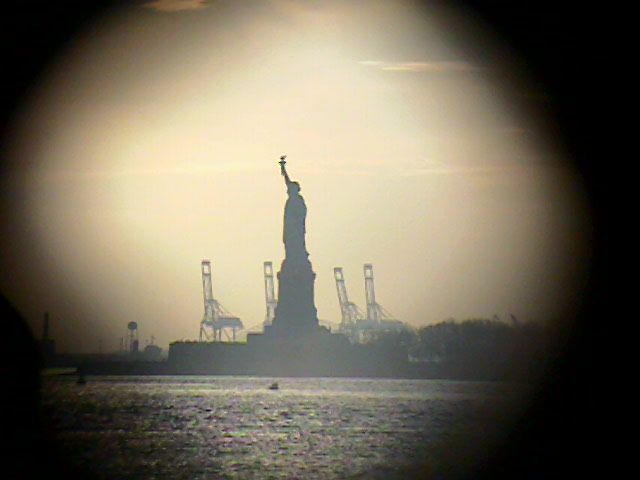|
|
LITR 4333 American Immigrant Literature 2009 final exam sample |
|
Jackie Baker
“WE are in Command of this Great Ship called America”
Throughout the semester, we have read about immigrants who want to be part of the “in-crowd”. Anzia Yezierska’s Bread Givers introduces us to Sara, a European immigrant who wants to be part of this elite culture. Sara wanted to part of this culture who wore, “Simple skirts, and sweaters with a simple quietness” (Yezierska 212). The immigrant’s strong desire for acceptance into the dominant culture has left me with many questions. First of all, what type of people make up the dominant culture? What led the dominant culture to believe that they must be in control? Secondly, special emphasis will be placed on the model minority, those groups of immigrants that assimilate partially, but also stay true to the values of their mother country.
Objective 4 gives us the first clue to the establishment of this culture as dominant in America. If one wants to begin joining the pieces of this giant jigsaw, we need not look any further than the “Great Migration” of English Pilgrims and the Puritans to North America. When the Pilgrims migrated to America, they came as a community. By coming as a community, the Pilgrims were better able to plant their seeds of custom and religion into the new country; these were the beginnings of the dominant culture. The Native Americans stood no chance of influencing the rigid non-accepting customs of the Pilgrims. The pilgrims came with no intention of assimilating; rather, they wanted to come and impose their ways of proper living on the “savages”. In Plymouth Plantation William Bradford makes the following statement about the Native Americans, “Thus it pleased God to vanquish their enemies [Indians] and give them deliverance” (10.6). Instead of respecting the religion and customs of the Native Americans, Bradford wanted his people to adamantly resist assimilation and any thoughts of intermarriage (Objective 1). For those who choose to partially assimilate, Morton and his people, to the ways of the Native Americans, Bradford says the following, “ They also set up a May-pole, drinking and dancing about it many days together, inviting the Indian women, for their consorts, dancing and frisking together, (like so many fairies, or furies rather,) and worse practices” (19.7). The need to be in control has begun to take control of the dominant culture.
For those who are wondering where the Pilgrims received much of their advice for living, they probably were greatly influenced by the historical migration of the Israelites out of Egypt. Both the pilgrims and the Israelites believed that they were the “chosen people”. As the chosen people, they were entitled to have control of the new lands. It wasn’t enough that they were part of this new land; they wanted to be in control. In the biblical account of numbers, God tells Moses the following, “Dispossess the inhabitants of the land, and therein; for I have given you the land to possess it” (Numbers 33.53). The Jews wanted to be dominant over all of the Canaanites and the Pilgrims wanted to have domain over the customs and religion of the Native Americans.
Now that the DC culture has been established in America, we will discuss what type of people make up this elite culture. In Letters from an American Farmer, Crevecoeur makes the following observation of the DC, “They are mixture of English, Scotch, Irish, French, Dutch, Germans, and Swedes” (Letter III). Based on these observations by Crevecoeur, the Caucasian race is its own melting pot of European countries mixed together. Crevecoeur makes a final observation about the DC, “Everything has tended to regenerate them; new laws, a new mode of living, a new social system” (Letter III). One thing that we must remember is that there were already customs established before the DC set foot on American soil. The Native Americans already had established their ways of living, but they had to take a back seat to the new domineering culture. Hence, the Native Americans become the minority culture; while, the Pilgrims rose to DC status.
Unlike the Native Americans, who were forced to become part of the minority culture, the model minority group chooses to immigrate to America. Even though both groups share the term minority, both groups are distinctly different. The minority story is not an immigrant story of voluntary participation and assimilation; rather, it is of involuntary contact and exploitation (Objective 1). The minority group resists any form of assimilation and tries to dissociate themselves from the DC. Contrastingly, the model minority is composed primarily of Jews, Indians and Asians. The model minority group engages in selective assimilation, which means that they assimilate partially to the ways of the DC, but they still retain the customs and religions of their mother country. The model minority group compromise with the DC by assimilating economically and financially, but there are some customs that they are adamantly retaining, such as language and religious customs.
The DC was born the day the Pilgrims first stepped on American soil. With their rigid non-accepting customs, the Pilgrims were able to quickly squash the customs and traditions of the Native Americans. The DC will continue to be a complex culture to analyze because they are within themselves a melting pot of cultures, ideas, and “unmarked” styles. It is truly difficult for an immigrant to assimilate to the DC because all the channels for infiltration have gracefully intermarried into culture that only exist in one place, America.
|
|
|
|


